Google Ads scripts: Everything you need to know
Streamline campaign management with Google Ads scripts. Get insights, use cases, and practical tips for using automation to boost performance.
If you’re a digital marketer, you know the challenge of juggling performance goals, tight budgets, and endless to-do lists.
Google Ads scripts offer a smarter way to manage your campaigns, introducing automation and real-time optimization that free you from repetitive tasks and let you focus on strategy and innovation.
With their ability to simplify complex processes and deliver actionable insights, Google Ads scripts enable marketers to work smarter, not harder.
From automating bid adjustments to generating custom reports, these tools let you stay efficient and agile in a competitive landscape.
This guide will give you the knowledge and tools you need to harness the full power of Google Ads scripts and transform your advertising strategy.
What are Google Ads scripts?
Google Ads scripts are powerful tools that help advertisers improve their campaigns by:
- Automating complex workflows.
- Enabling data-driven optimizations.
- Unlocking advanced functionality through customizable JavaScript code.
Introduced in 2012, these scripts were designed to simplify campaign management and offer a more efficient alternative to manual work.
When integrated with tools like Google Sheets, Google Analytics, and external APIs, Google Ads scripts become powerful allies, helping advertisers of all sizes stay agile and competitive.
Despite their potential, adoption remains limited. About 19% of advertisers don’t use any scripts and an additional 63% use between 1 and 5 scripts, according to 2024 data from PPCSurvey.com.
Considering their efficiency and customization capabilities and that Google allows 250 scripts to be used in an account, this utilization level is surprisingly low.
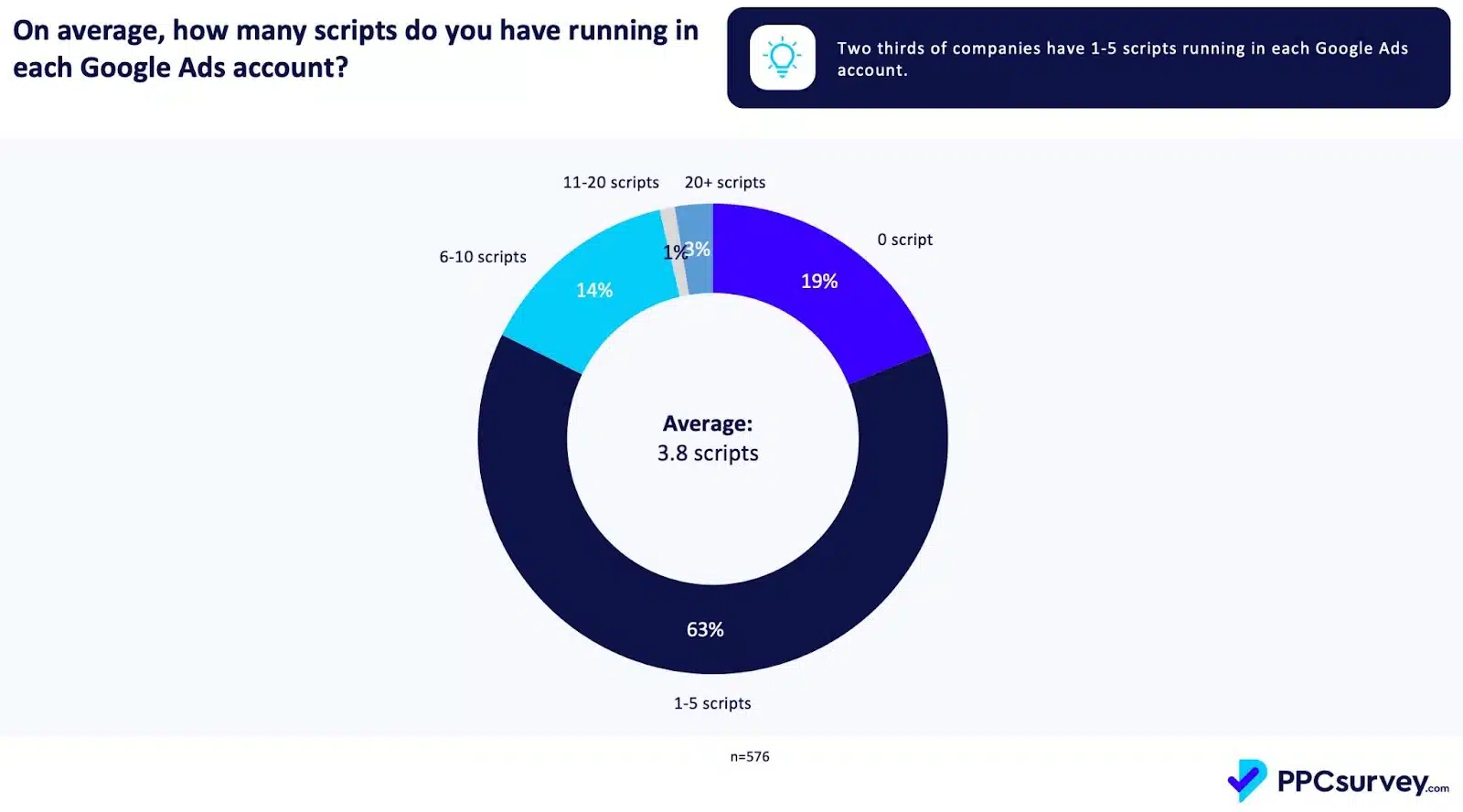
Let’s explore their unique advantages and challenges to help you evaluate their fit for your automation needs.
Advantages of Google Ads scripts
- Time savings: Automate repetitive tasks, allowing more focus on strategy and growth.
- Customization: Write scripts tailored to specific business goals and campaign needs, offering flexibility that is not always available with other tools.
- Rapid iteration: Quickly test and deploy changes without waiting for developer support or platform updates.
- Scalability: Use MCC scripts to manage multiple campaigns or accounts efficiently.
- Budget monitoring: Implement precise controls to monitor and adjust budgets, reducing the risk of overspending.
Challenges and limitations
- Technical skills required: A working knowledge of JavaScript is necessary to write or modify scripts effectively.
- Execution time limits: Scripts are capped at a 30-minute execution window, requiring careful planning for complex tasks.
- Quota constraints: Scripts must operate within Google Ads API quotas, making efficient coding essential.
- Maintenance needs: Scripts require regular updates to ensure compatibility with changes in the Google Ads platform.
- Limited built-in support: Debugging and troubleshooting can be time-intensive, requiring the use of logs and error tracking.
Ads scripts vs. automated rules vs. API
Scripts aren’t the only solution for automating PPC tasks – automated rules and APIs also offer powerful ways to streamline your campaigns.
Each option has its strengths, so it’s important to consider your goals, technical skills, and desired level of control.
Google Ads scripts
- Strengths: Highly customizable, supports integration with external tools and APIs, enables dynamic, real-time adjustments.
- Use cases: Complex optimizations (e.g., weather-based bidding), multi-account management, advanced reporting.
- Limitations: Requires JavaScript knowledge, subject to execution time and quota limits.
Automated rules
- Strengths: Easy to use, no coding required, suitable for basic automation like pausing ads or adjusting budgets.
- Use cases: Simple, predefined conditions (e.g., pausing low-performing ads).
- Limitations: Limited flexibility and scope; cannot integrate with external data or APIs.
Google Ads API
- Strengths: Offers full control and scalability, suitable for enterprise-level needs, supports bulk operations.
- Use cases: Large-scale account management, integrating Google Ads data into custom dashboards.
- Limitations: Requires significant technical expertise and infrastructure; more complex to implement compared to scripts.
Dig deeper: 7 Google Ads features to streamline your workflow
Practical use cases of Google Ads scripts
Google Ads scripts excel in delivering automation and optimization across various campaign scenarios. Here are some of the most impactful use cases.
Performance-based bid adjustments
Automatically adjust Target CPA bids to prioritize high-converting traffic.
For example, increase Target CPA thresholds by 10% during peak hours for campaigns generating high conversion volumes.
Weather-triggered campaigns
Adjust bids dynamically based on weather data retrieved via an API. For example, raise bids for rain gear in cities where rain is in the forecast.
Seasonal campaign activation
Activate or pause campaigns at specific times, ideal for holiday promotions. For example, automatically launch Black Friday ads at midnight.
Ad variant testing
Pause underperforming ad creatives after a testing period. For example, pause ads with conversion rates below 1% after two weeks.
Daily budget oversight
Pause campaigns that exceed daily spend limits to prevent overspending.
Automated reporting
Generate customized reports and deliver them via email on a schedule (e.g., daily, weekly).
For example, email a performance summary every morning, detailing impressions, CTR, and conversions.
Multi-account management
Use manager account (MCC) scripts to simultaneously adjust bids, budgets, or other settings across multiple accounts.
For example, adjust bids for all accounts during specific peak hours.
Data integration with external sources
Enhance campaigns by integrating data from Google Sheets, Google Analytics, or external APIs.
For example, dynamically adjust campaigns based on competitor pricing or inventory levels.
These examples demonstrate the versatility of Google Ads scripts in addressing common challenges while driving efficiency and precision in campaign management.
How Google Ads scripts work
Setup and execution
Scripts are managed within the Google Ads interface under Tools & Settings > Scripts.
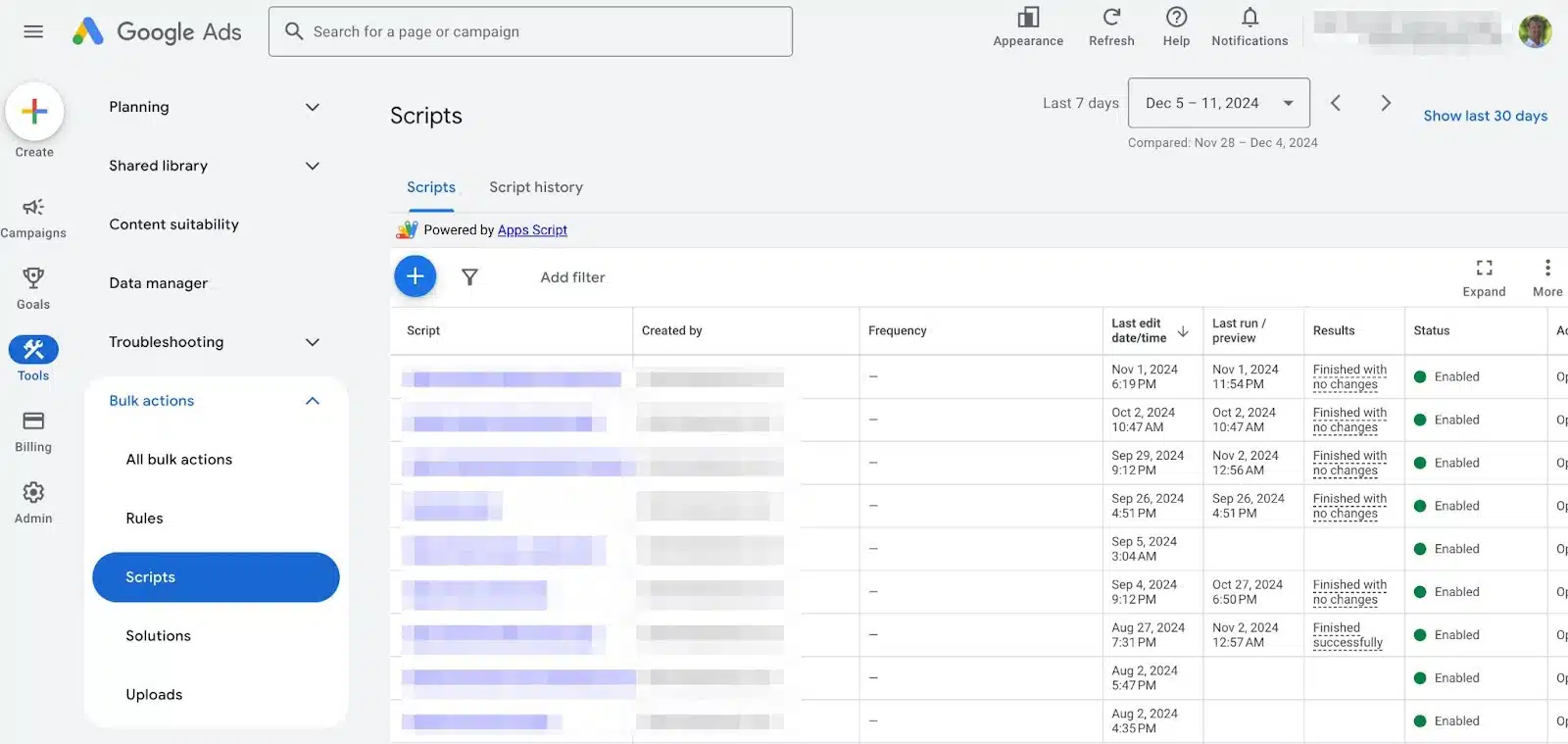
Advertisers can write, test, and schedule scripts directly from this dashboard.
- Write the script using the Google Ads Script editor or copy-and-paste a script you found on a trustworthy site.
- Preview changes before live deployment to avoid making unexpected changes to your account.
- Save the script for manual use when needed or schedule it to run at desired intervals. Scripts can be run as often as once per hour.
When previewing a script to confirm it works as intended, pay close attention to two important sections:
- Logs.
- Changes.
The logs show details about all the steps a script goes through but it may be blank unless the script uses the Logger.log() function to write output to this section.
Changes will show if any parts of your account would change if the script were run in normal mode (not preview mode).
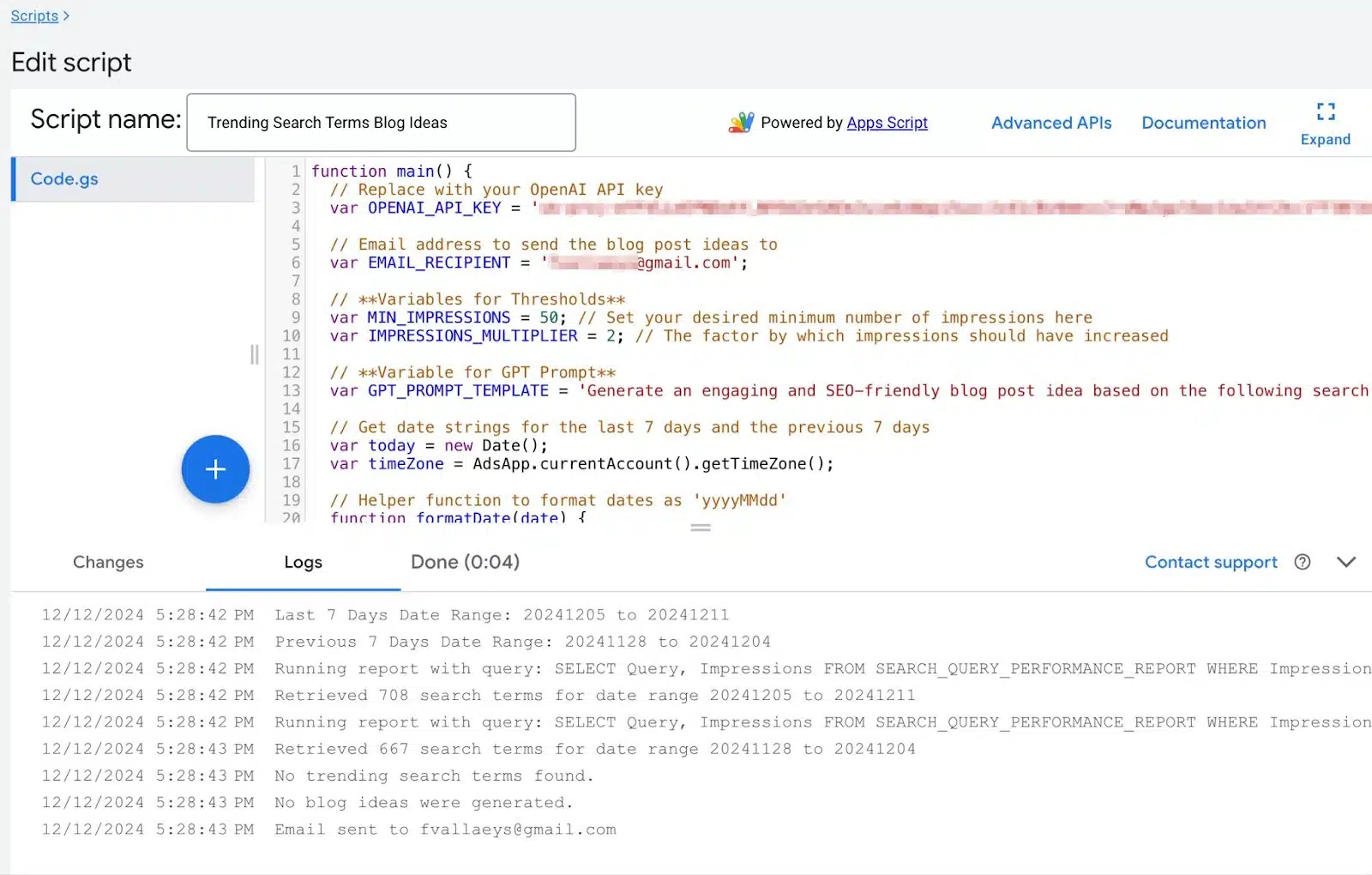
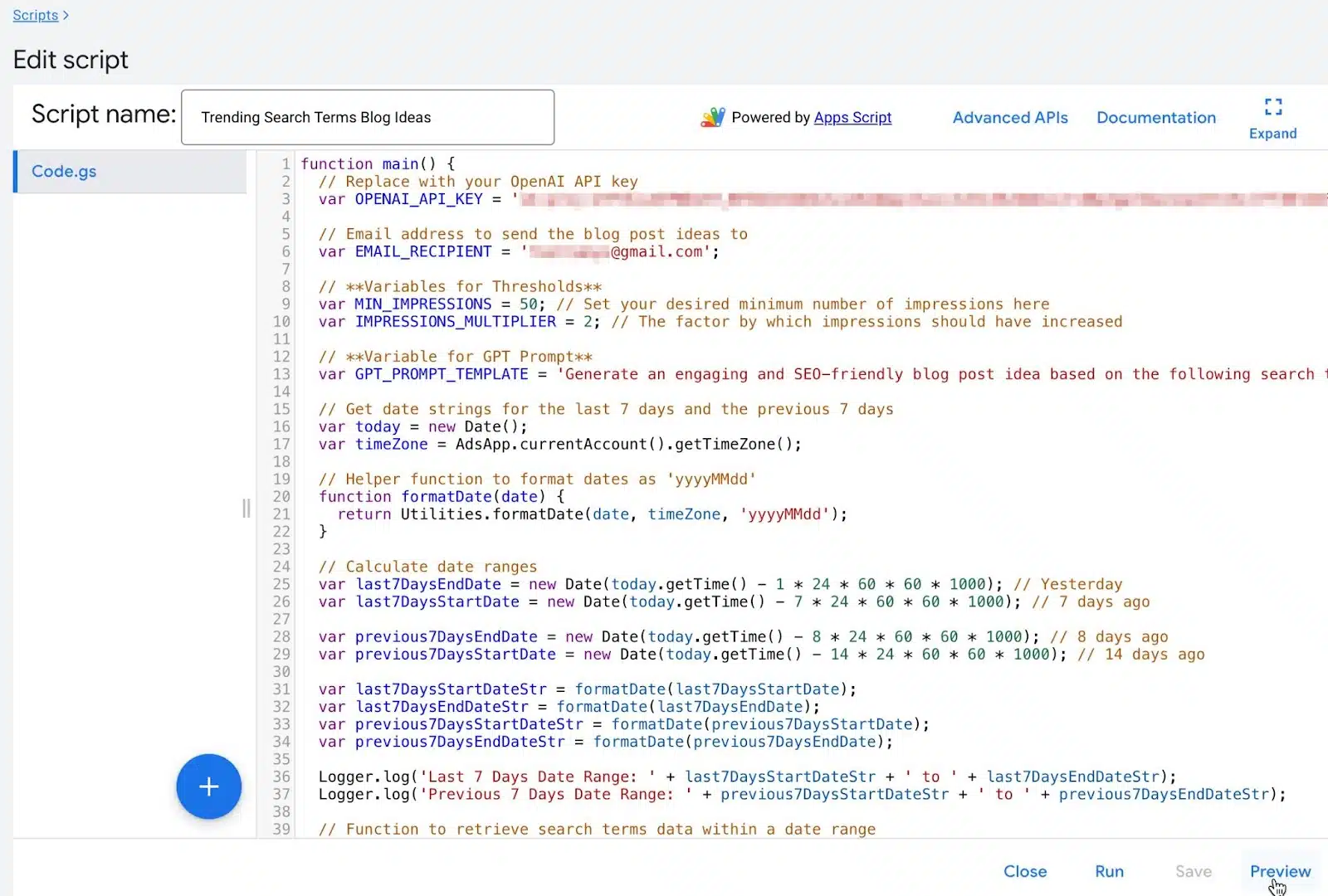
Scripts in action: Real-world examples from Search Engine Land
Over the years, various Google Ads scripts have been developed and shared to address specific challenges faced by advertisers.
Here are some practical examples, each accompanied by links to the detailed articles on Search Engine Land:
- Responsive Search Ad (RSA) generation: “A Google Ads script that uses GPT to write RSAs”
- Budget monitoring: “A script to set recurring monthly budgets in [Google Ads]”
- Ad performance management: “Find the best text for new ads using an n-gram analysis”
- Performance alerts: “Granular [Google Ads] account anomaly alerts”
- Feed-based automation: “Automate adding [Google Ads] data to a Google spreadsheet”
Example script: Pausing low-quality keywords
Here’s a simple script to pause keywords with a Quality Score below 3:
function main() {
var keywords = AdsApp.keywords()
.withCondition("QualityScore < 3")
.get();
while (keywords.hasNext()) {
var keyword = keywords.next();
keyword.pause();
Logger.log("Paused keyword: " + keyword.getText());
}
}How to use the script
- Copy the script into the Google Ads Script editor.
- Preview it to ensure it identifies the right keywords.
- Schedule it to run daily or weekly for ongoing optimization.
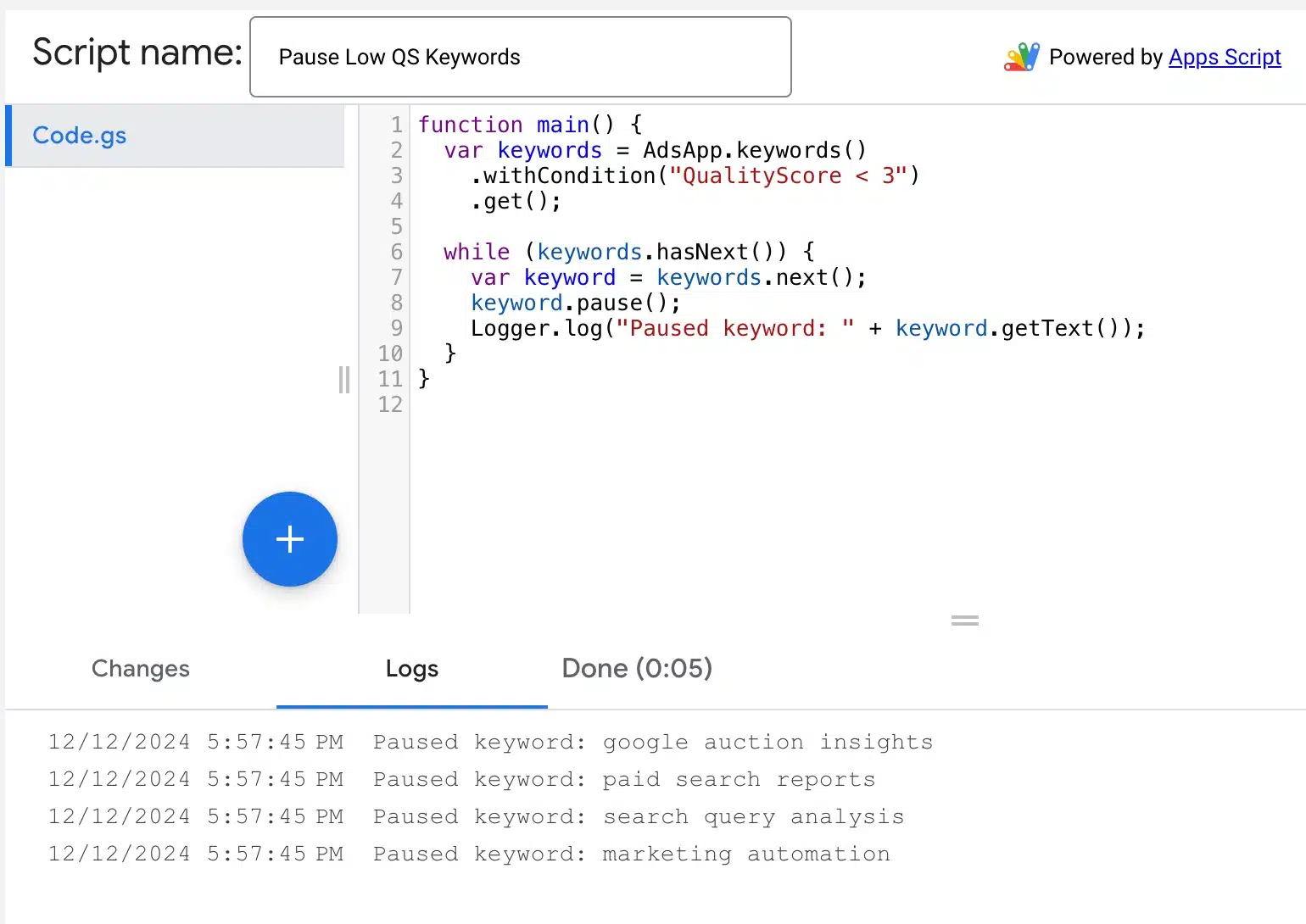

Best practices for using Google Ads scripts
Start simple
- If you’re new to scripting, begin with pre-written templates or basic examples available in resources like Google Ads’ official documentation or Optmyzr (disclosure: I co-founded the company). This will help you build familiarity and confidence.
Write modular and maintainable code
- Create reusable, maintainable functions to keep scripts organized and scalable. A modular structure simplifies debugging and future updates.
Test before deployment
- Always preview and test scripts in a sandbox environment to identify bugs and avoid unintended consequences, such as pausing active campaigns or exceeding budgets.
Incorporate error handling
- Use
try-catchblocks to prevent scripts from crashing entirely when encountering issues. Log errors to facilitate efficient debugging and ensure consistent execution.
Optimize API usage
- Minimize unnecessary API calls by batching requests and retrieving only the data you need. This helps avoid exceeding API quotas and slowing script execution.
Avoid over-reliance on automation
- While scripts are powerful tools for repetitive and data-driven tasks, they should complement, not replace, strategic oversight.
- Reserve tasks requiring subjective judgment for human input to maintain campaign effectiveness.
Security and compliance considerations
When using Google Ads scripts, it’s essential to prioritize security and compliance to protect data integrity and avoid disruptions.
Access control
- Limiting script deployment and editing permissions to admin-level users helps prevent unauthorized changes and potential data exposure.
Data privacy
- Compliance with GDPR and other relevant regulations protects user data and minimizes legal risks.
API security
- Secure authentication methods, such as OAuth, are critical when integrating with external APIs to prevent unauthorized access and data breaches.
Error logging and monitoring
- Maintaining an audit trail through error logging helps quickly identify and resolve issues.
- Poorly tested scripts can disrupt campaigns or lead to budget overruns, highlighting the importance of continuous monitoring.
Regular reviews and dependency management
- Regularly reviewing scripts ensures they remain relevant and secure.
- Additionally, being prepared for external API or data source failures helps mitigate disruptions.
Implementing these practices effectively reduces risks and ensures a secure, compliant Google Ads environment.
Advanced debugging techniques
Troubleshooting Google Ads scripts requires a systematic approach to identify and resolve issues effectively.
Some debugging tools include:
- Logger: Use
Logger.log()to output variable values and flow checkpoints during script execution. - Preview mode: Run scripts in preview mode to inspect changes without applying them.
- Error logs: Enable detailed error logging to capture stack traces and identify code issues.
When debugging, make sure to:
- Identify the problem: Analyze script behavior and logs to isolate the issue.
- Check preconditions: Verify input data and conditions used in the script.
- Conduct iterative testing: Modify and test scripts in small increments to pinpoint errors.
- Seek help: Leverage community forums like Stack Overflow for advice on specific issues.
Tools, communities, and resources for Google Ads scripts
Mastering Google Ads scripts requires the right combination of tools, community support, and educational resources.
Whether you’re troubleshooting, learning the basics, or seeking advanced solutions, the following platforms and resources will empower you to take full advantage of scripts.
Official documentation and learning resources
- Google Ads scripts documentation: Learn the fundamentals, explore official examples, and access detailed guides for various use cases.
- Google Ads Help Center: Provides tutorials and FAQs for setting up and using scripts effectively.
Online communities
- Stack Overflow: A go-to platform for developers to troubleshoot issues, share code snippets, and collaborate on advanced scripting challenges.
- Reddit (r/PPC): Engage with PPC professionals discussing strategies, scripts, and campaign optimization.
Pre-built scripts and tools
- Optmyzr: Offers a library of pre-built scripts, templates for automation, and enhanced reporting capabilities. It’s an excellent resource for advertisers managing multiple accounts.
- GitHub repositories: Explore open-source Google Ads Script libraries shared by the developer community. Many repositories include unique solutions for dynamic campaign adjustments, bid optimizations, and reporting.
Paid educational resources and services
- Online courses: Platforms like Udemy and Coursera offer courses on JavaScript and Google Ads scripts for all skill levels.
- Consulting services: Professional consulting firms provide custom script development, implementation, and optimization services tailored to your business goals.
Where to find ready-to-use scripts
If you’re new to Google Ads scripts or want to save time, leveraging pre-built scripts from reputable sources can be invaluable.
Here are some of the best places to find ready-to-use scripts:
Google Ads scripts documentation
- The official Google Ads scripts documentation provides a comprehensive collection of example scripts and code snippets for various automation tasks.
- This is an excellent starting point for advertisers of all experience levels.
Nils Rooijmans’ free Google Ads scripts library
- PPC expert Nils Rooijmans has curated an extensive library of over 400 free PPC scripts.
- These scripts address a wide range of use cases, from bid adjustments to reporting.
KlientBoost’s Google Ads scripts compilation
- KlientBoost shares their top 14 favorite Google Ads scripts designed to enhance efficiency and campaign performance.
- This resource is particularly useful for marketers looking to implement impactful changes quickly.
These resources provide an excellent foundation for integrating pre-built scripts into your campaigns.
They allow you to automate tasks without starting from scratch and give insight into how scripts can solve common challenges in Google Ads management.
Writing Google Ads scripts with GPT
GPT has revolutionized how marketers create Google Ads scripts, making the process faster, easier, and more accessible.
By streamlining script creation, GPT allows marketers to focus on optimizing performance rather than getting bogged down in technical details.
These practical tips will help you optimize GPT’s output and troubleshoot effectively.
Describe your goals clearly
- Be specific about what the script should accomplish.
- Include key metrics (e.g., CTR, conversion rate) and any integrations (e.g., Google Sheets, external APIs).
- Example input: “Write a script to pause keywords with a Quality Score below 3 and log them in a Google Sheet.”
Start small and scale
- Begin with a basic script generated by GPT and test it.
- Once you’re confident it works, expand its functionality to handle more complex tasks.
Leverage visual inputs
- If you have a workflow diagram or a logic flowchart, upload it to GPT-supported platforms. GPT can interpret these visuals and convert them into working code.
- Example: Include a sketched flow showing how ads with low CTR should be paused.
Test iteratively
- Use Preview Mode in Google Ads to test scripts before deployment.
- Share logs or output with GPT to refine code and fix errors.
Collaborate on refinements
- If the script doesn’t work as expected, share the error logs with GPT for troubleshooting.
- Example: “Here’s the error I encountered while running the script. Suggest fixes to resolve it.”
What’s next for scripts?
As Google Ads scripts continue to evolve, the possibilities for automation and optimization are boundless. Here’s what the future may hold:
Enhanced flexibility and integration
- Google Ads scripts offer enhanced flexibility through more robust integrations with external APIs and data sources, enabling support for increasingly complex use cases.
- These improvements also include expanded capabilities for multi-account management and data visualization, which provide users with greater control and deeper insights into their campaigns.
User-driven innovation
- Early on, the Google team behind Ads Scripts thought the toolset was complete. However, feedback from the advertiser community has driven continuous improvements.
- For instance, during a casual meeting at the Sports Page, a local pub in Mountain View, I shared some use cases the scripts couldn’t handle.
- The Google team genuinely appreciated and noted the importance of advertisers highlighting real-world needs. They’re not advertisers themselves, and community input remains vital for future updates.
AI-assisted scripting
- AI-assisted scripting is becoming increasingly powerful, with greater integration of AI tools to help advertisers write, debug, and optimize scripts more efficiently.
- Enhanced multi-modality capabilities now allow input in various formats, such as images and flowcharts, making script generation more accessible and adaptable to diverse workflows.
Focus areas for growth
- Improved error handling and debugging tools could make scripts easier to manage and troubleshoot.
- Additionally, better educational resources could be developed to support non-technical users, lowering the learning curve.
- Expanded quotas and execution limits are also on the horizon, enabling the handling of more complex scripts with greater efficiency.
The collaboration between Google’s development team and the advertiser community will continue to shape the future of Google Ads scripts, unlocking even more campaign management and optimization opportunities.
Transforming the way you manage Google Ads
Google Ads scripts have evolved from a niche tool to an essential resource for marketers aiming to scale their efforts without sacrificing precision.
They enable advertisers to automate repetitive tasks, respond to data in real time, and implement strategies that would be impossible to execute manually.
The beauty of Google Ads scripts isn’t just in their complexity or capability – it’s in their accessibility.
Whether you’re customizing your scripts with GPT, using pre-built templates, or integrating external APIs, the possibilities are only limited by your creativity and ambition.
By embracing this automation powerhouse, you’re not just managing your campaigns – you’re redefining them for the better.
Contributing authors are invited to create content for Search Engine Land and are chosen for their expertise and contribution to the search community. Our contributors work under the oversight of the editorial staff and contributions are checked for quality and relevance to our readers. The opinions they express are their own.
Related stories
New on Search Engine Land